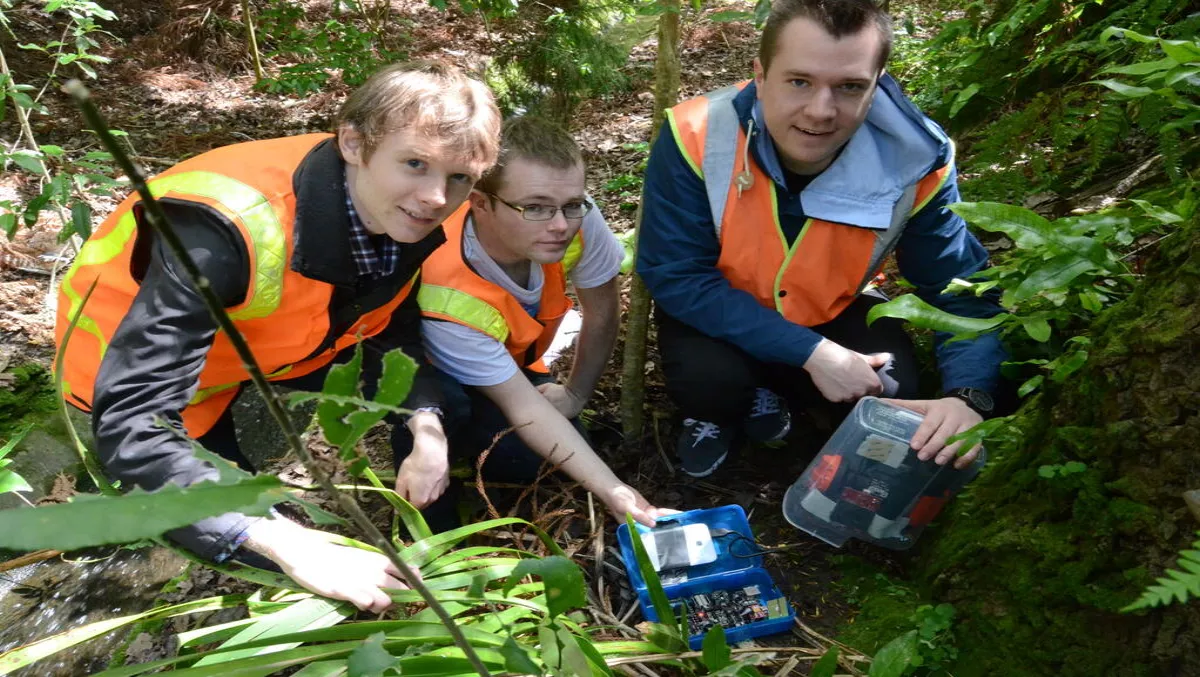
A trio of third-year University of Waikato computer science students has designed a unique monitoring system for hi-tech rat traps, which can be used to collect data on the range of pests that threaten the kiwi in its natural environment.
Jourdan Templeton, Nathan Holland and Stephen Quayle, all aged 22, designed the prototype of their system using all Microsoft technologies, and recently completed a successful trial at the Hamilton Gardens.
Called ‘Ohiti’, a Maori word meaning ‘watchful’, the monitoring system utilises humane pest traps designed by Wellington-based company Goodnature, which are currently used by the Department of Conservation to kill possums, rats and stoats.
The trap works by luring pest animals into it with a peanut-based bait. When the trap is triggered, a CO2 gas-powered pneumatic bolt fires, killing the rat instantly. No poison is used, and the traps are self-reloading, firing up to 24 times before needing to be reset.
The Ohiti system works by connecting a small transmitter to each trap that records each time it is triggered. The collected data is then relayed in real time to a base unit and after processing, is then uploaded to a server on Microsoft’s cloud platform, Azure.
During the month-long trial, the students set up a chain of three rat traps about 50 metres apart in a gully area of the Hamilton Gardens.
“The idea was to test the technology in a real world situation, dealing with real problems, and that’s what we’ve managed to do,” Holland says. “We even got to knock off a few rats in the process!”
Templeton says the results of the Ohiti trial demonstrates the potential technology has in aiding the conservation and preservation of kiwi.
“Our goal was two-fold,” he says. “Firstly, we wanted to make it easy to maintain the traps without sending people on a hike to check each one.
“Secondly, we wanted to provide a portal which would enable conservationists to be more proactive in protecting native species.
“We collect a wide range of data every time a trap is activated, which can provide information about the environment and the impact of pests in the area. For example, Ohiti could tell you the most active time for rats in summer.”
“Ultimately, we’ve been able to show how Ohiti can reduce operational costs, meaning more money can be made available to protect our kiwi.”

Microsoft technologies key to development of Ohiti system
Templeton says the use of Microsoft technologies was key in the development of the Ohiti system, particularly in the early stages.
In its initial development stage, the team used the Microsoft .NET Gadgeteer prototyping platform, which is used specifically for creating small electronic gadgets and embedded hardware devices. It allows for solderless assembly of electronics using a kit of hardware modules, and quick physical enclosure fabrication using computer-aided design.
“Thanks to the Gadgeteer platform, we had our first working prototype of Ohiti within hours of getting the hardware to play with,” says Templeton. “It also meant that we could easily share common code between the different layers of the project.”
Templeton says one of the main challenges for the team was creating a waterproof housing for the Ohiti units so their electronics would continue to operate effectively, even in the rain.
“At the moment the transmitter technology works best in parks or bush-land near built-up areas as it is operating on a 2.4 gigahertz frequency. As the technology evolves, it will be able to be used in a broader range of environments,” says Stephen Quayle.
The team used Microsoft’s Visual Studio 2013 as their development tool of choice, while the Microsoft Azure cloud hosted both their source code and the Ohiti web application.
“We take all the collected data and process it,” Templeton adds. “This allows us to create useful metrics and models to get a greater insight into the environment.
“It also helps with maintenance of the traps themselves. We built an app for Windows 8 that makes this easy.”
Templeton says the development of the Ohiti system was also made possible through Microsoft’s start-up programme BizSpark, through which they were able to get an MSDN subscription for access to software licenses and the Microsoft Azure cloud platform.
“For our latest prototype we have moved to a more permanent solution which runs directly on the Microsoft .NET MF core,” Templeton says.
“What this shows is that Microsoft has been at the core of the Ohiti’s system’s evolution throughout, from prototype to a more final product.
“Our hope is that people will catch the vision of how technology can rapidly aid efforts to conserve New Zealand’s natural environment.”